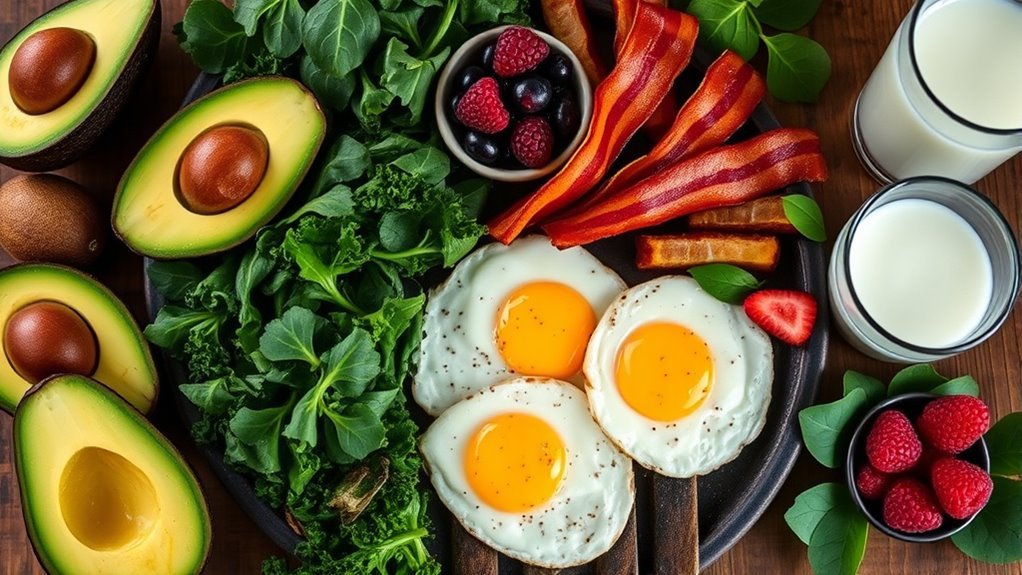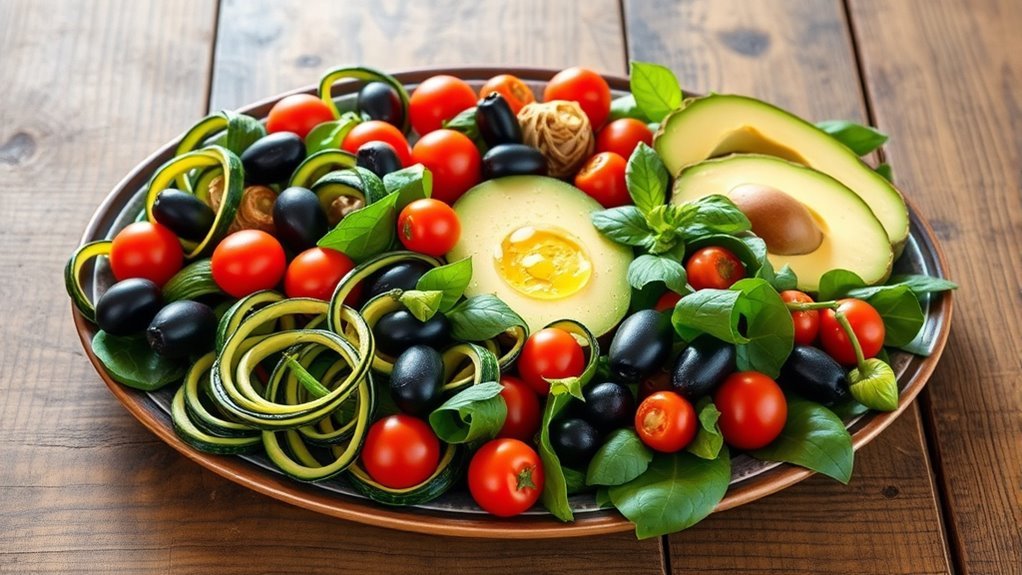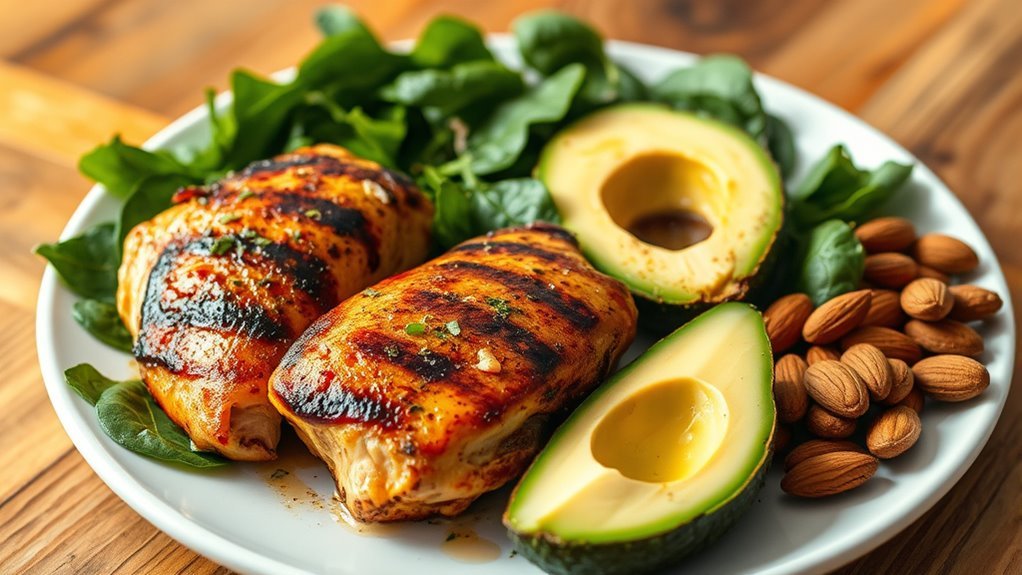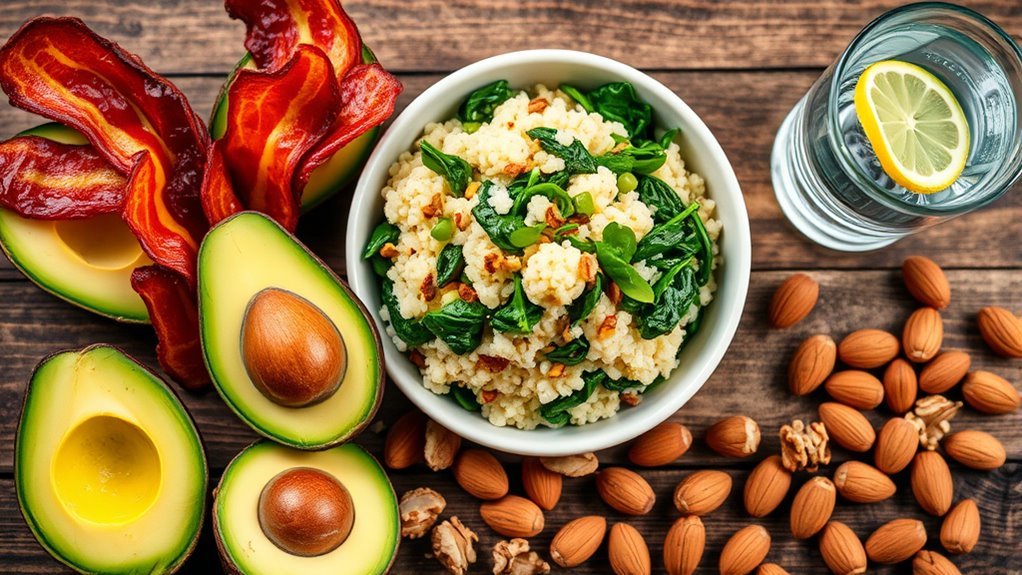On the keto diet, you can enjoy a variety of low-carb vegetables like spinach, zucchini, and cauliflower. Focus on high-quality protein sources such as lean meats and seafood. Healthy fats, including avocado oil, coconut oil, and nuts, are essential for achieving ketosis. Don’t forget to include low-carb snacks and beverages, like herbal teas and bone broth. These options support your dietary goals while keeping meals exciting. There’s more to discover about what fits into your keto lifestyle.
Understanding the Ketogenic Diet Principles

While many diets focus on calorie counting and portion control, the ketogenic diet revolves around drastically reducing carbohydrate intake and increasing fat consumption to trigger a state of ketosis. This metabolic state allows your body to burn fat for fuel instead of carbs, which can lead to weight loss and improved energy levels. When you initiate keto meal planning, you’ll want to prioritize high-fat, moderate-protein foods while minimizing carbs. This often means you’ll need to be diligent about carb counting to stay within your daily limits. By embracing this lifestyle, you can enjoy a range of flavors while achieving your health goals. Ultimately, the ketogenic diet offers a sense of freedom from traditional dieting restrictions, allowing you to nourish your body in a fulfilling way.
Low-Carb Vegetables to Include

When following a keto diet, incorporating low-carb vegetables can enhance your meals while keeping your carbohydrate intake in check. You’ll find that options like spinach, zucchini, and cauliflower not only provide essential nutrients but also offer versatility in cooking. Let’s explore the best choices, their nutritional benefits, and some creative ways to prepare them.
Best Options Available
If you’re aiming to maintain a ketogenic diet, incorporating low-carb vegetables is essential for meeting your nutritional needs without exceeding your carbohydrate limits. Great options include leafy greens like spinach and kale, cruciferous vegetables such as broccoli and cauliflower, and other low-carb choices like zucchini and bell peppers. These veggies not only fit well into your keto meal prepping but also make it easier to stay on track when dining out. You can enjoy them grilled, steamed, or in salads while adding flavor to your meals without the carbs. Remember, the key is variety; mixing different vegetables can keep your meals exciting and satisfying while supporting your keto lifestyle. Enjoy the freedom that comes with making these choices!
Nutritional Benefits Explained
Including low-carb vegetables in your keto diet not only helps you stay within carbohydrate limits but also provides numerous nutritional benefits. These vegetables, like spinach, zucchini, and broccoli, are packed with vitamins, minerals, and antioxidants while being low in calories. They’re essential for maintaining overall health, especially during keto meal planning. Plus, when you check nutritional labels, you’ll see that these veggies contribute fiber, which aids digestion and promotes satiety, helping you feel full longer. Incorporating a variety of low-carb vegetables can prevent nutrient deficiencies and support your body’s needs as you commence your keto journey. So, embrace these veggie options and enjoy the freedom of delicious, nutritious meals without compromising your carb goals!
Cooking Tips and Ideas
While preparing meals on a keto diet, you’ll want to get creative with low-carb vegetables to maximize flavor and nutrition. Incorporating these veggies into your keto meal prep can elevate your dishes and keep your carb count in check. Here are four fantastic options:
- Zucchini – Great for zoodles or grilled, it’s versatile and low in carbs.
- Spinach – A nutrient powerhouse, it’s perfect in salads or sautéed with garlic.
- Cauliflower – Use it for rice, mash, or pizza crusts; it’s incredibly adaptable.
- Broccoli – Full of fiber and vitamins, steam or roast it for a nutrient-rich side.
Explore different cooking techniques to bring out the best flavors in these vegetables. Enjoy the freedom of creativity in your keto cooking!
Protein Sources for Keto

When you commence a keto diet, selecting the right protein sources is vital for maintaining your macronutrient balance and supporting overall health. Lean meats such as chicken, turkey, and pork are excellent choices, providing high-quality protein without excessive carbohydrates. These options can help you feel full while fueling your body efficiently. Seafood options, including salmon and shrimp, not only deliver protein but also offer healthy omega-3 fatty acids, important for reducing inflammation and supporting heart health. Incorporating a variety of these protein sources guarantees you get a range of nutrients while sticking to your keto goals. Remember, balance is key, and diversifying your protein intake can make your keto journey both enjoyable and sustainable.
Healthy Fats for a Ketogenic Lifestyle
When following a ketogenic lifestyle, incorporating healthy fats is essential for achieving and maintaining ketosis. You’ll want to focus on types of healthy fats, choose the right cooking oils, and enjoy the benefits of avocados and nuts. Understanding these options can help you create balanced meals that support your health goals while adhering to the keto diet.
Types of Healthy Fats
Incorporating healthy fats into your ketogenic diet is essential for achieving and maintaining ketosis, as these fats serve as the primary source of energy. Understanding the types of beneficial fats can help you make informed choices. Here are some healthy fat sources to take into account:
- Avocado oil – Rich in monounsaturated fats and great for heart health.
- Coconut oil – Packed with medium-chain triglycerides (MCTs) that can boost energy and support fat burning.
- Nuts and seeds – Almonds, walnuts, and chia seeds are excellent sources of healthy fats and fiber.
- Olive oil – Known for its anti-inflammatory properties, it’s perfect for drizzling on salads or veggies.
Incorporate these beneficial fat types to fuel your keto journey effectively!
Cooking Oils Selection
Choosing the right cooking oils is essential for anyone following a ketogenic lifestyle, as these oils not only enhance flavor but also provide important healthy fats. Olive oil is a fantastic choice; it’s rich in monounsaturated fats and antioxidants, making it heart-healthy. Use it for dressings or low-heat cooking to maintain its benefits. Coconut oil, on the other hand, is perfect for high-heat cooking due to its stability. It contains medium-chain triglycerides (MCTs), which can aid in fat burning and provide quick energy. By incorporating these oils into your diet, you can enjoy delicious meals while staying aligned with your keto goals. Remember, the right fats can empower your culinary creativity and support your health.
Avocado and Nut Benefits
While many foods can fit into a ketogenic diet, avocados and nuts stand out as exceptional sources of healthy fats. Incorporating these into your meals not only enhances flavor but also boosts your overall health. Here are some key benefits:
- Avocado Nutrition: Packed with fiber, potassium, and monounsaturated fats, avocados help maintain heart health and support weight management.
- Nut Varieties: Almonds, walnuts, and macadamias provide essential nutrients and are low in carbs, making them perfect for snacking.
- Satiety: The fats in avocados and nuts promote fullness, reducing the urge to overeat.
- Versatility: Both can be easily added to salads, smoothies, or enjoyed on their own, giving you freedom in your meal planning.
Embrace these nutrient-dense options for a satisfying ketogenic lifestyle.
Keto-Friendly Snacks and Treats
When you’re on a keto diet, finding snacks and treats that fit your low-carb lifestyle can be a challenge, but it’s definitely achievable with a little creativity. Consider keto snack ideas like cheese crisps or pepperoni chips for a savory crunch. You can also whip up some guacamole or enjoy a handful of nuts like macadamias or pecans. If you’re craving something sweet, try dark chocolate with a high cocoa percentage or homemade fat bombs made with coconut oil and nut butter. Greek yogurt (unsweetened) is another option if you choose wisely. These low carb treats not only satisfy cravings but also keep you on track with your keto goals, allowing you the freedom to enjoy delicious snacks without guilt.
Beverages That Fit the Keto Diet
Staying hydrated is essential on a keto diet, and fortunately, there are plenty of beverage options that align with your low-carb lifestyle. Here are some great choices to keep you refreshed:
- Keto Smoothies: Blend up some spinach, avocado, and unsweetened almond milk for a delicious low-carb treat.
- Herbal Teas: Varieties like chamomile or peppermint are naturally caffeine-free and can be enjoyed hot or iced.
- Sparkling Water: Opt for flavored versions without added sugars to satisfy your carbonation cravings.
- Bone Broth: Not only hydrating, but it’s also rich in nutrients and keeps you feeling full.
With these options, you can easily stay hydrated while enjoying your keto journey!


